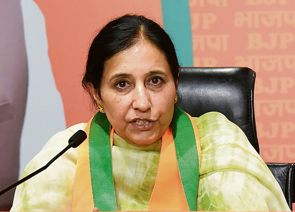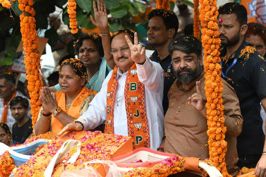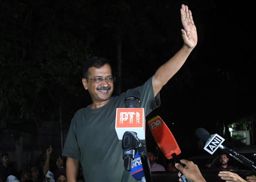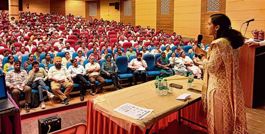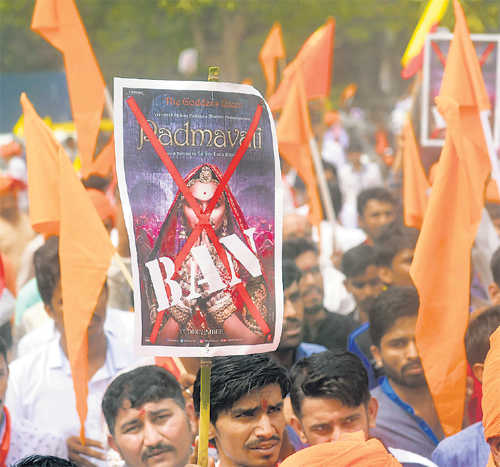
Gurupdesh Singh
Guru Nanak Dev University, Amritsar
Every now and then, we have controversies like Padmavati where people get in rage and choose to assert their opinions with violence or mass protest. The basic assumption that triggers such fierce reactions is their belief that the received history is all fact, sacrosanct and manifests the final truth. Little do they understand that they are made to read the history that they would love to read. Historians are no angels and cannot give up their biases or national pride or compulsions of writing an ideological tract.
History is not objective
The Padmavati imbroglio, therefore, has to be understood at two levels. First, that no version of history can be called the ultimate or objective. Reading just the first few pages of EH Carr's What is History will enlighten us about the process of writing history. The facts that we have about a particular historical event keep adding or revising as new sources of information, reliable or not, are dug up. A historian, therefore, will always have access to a limited number of facts at any given time. As all facts or details cannot be included, he chooses to highlight some, turning them into what Carr calls 'historical facts'. Like any other phenomenon, historical facts are the data which need interpretation and hypothesis-making. A historian, as a writer, has the freedom to interpret that data to suit his interests or those of his readers. He can also choose arbitrarily to emphasise or ignore a certain set of facts to build his point of view. These liberties are not taken randomly but always governed by the compulsions of power structure within which a historian works.
Two versions of the same event
Such an understanding of history will make us see the volatile and unstable nature of any history. It would bring home the futility of such an aggression as Padmavati has raised. How does it matter if there are two versions of the same event? Can we recall here the two divergent narratives of the common struggle that India and Pakistan had for their independence? In Pakistan's history of independence, we come across events and names that never find any mention in our history books. They valorise the contribution of such vague heroes as Maulana Shaukat Ali, Aga Khan, Maulana Muhammad Ali Jouhar, and rarely mention any Indian names, except Gandhi and Nehru. If we have found peace in these two historical versions, we can easily dismiss issues like Padmavati as minor aberrations. A longstanding version of received history cannot be undone by such small commercial acts.
The second aspect that needs to be understood is the precise nature of representations, especially those which, for some reasons, are considered imaginative or artistic. Although, these days, many people do not make any difference between the documentary and artistic as both are mediated entities and subject to an individual's personal or ideological or artistic choices. However, it is easy to see how a work of art like literature, film or painting shows distinct signs of aesthetic liberty that an artist takes. Readers of literature do understand that even when Kamala Das by her title and direct exhortation claims My Story to be autobiographical, it cannot be entirely read like that. It has elements of selective narration, melodramatic events and a sprinkling of titillation, all packed in with an intent to seduce the reader. The text presents a good mix of biography and fiction and one can see it clearly.
Arts have an imaginative take
This actually is the case with all forms of art, and there is no point in looking for authenticity. We enjoy historical novels or films not because they represent any historical truth about the characters or events, but because of the pleasure that we derive from their artistic representation. Did we enjoy Mughal-e-Azam because it represented any true history? Or do we think that Gandhi the film represented a true picture of the Mahatma or the history of his times? If that was the case, why did the historians never mention the case of a woman who received his help while taking bath by the river semi-clad? Also, if Gandhi of the film was so true to history, why was it banned in the neighbouring country which witnessed his life as much as we did? As one reporter summed up in those days, Gandhi in Pakistan is viewed as "a convincing hypocrite and a consummate manipulator." We, in this country, may not share these views but can find many who may have no kind words for him.
We must understand that people can have different perspectives and judgments on historical figures and events depending upon their political leanings. Similarly, arts, particularly the glamourised world of cinema, can have an imaginative take on historical events sometimes to mark resistance and sometimes, in plain terms, to meet the demands of commercial success.
Regarding the film Padmavati, it is interesting to note that people have raised arms against the film even without watching it. Nobody knows what is wrong with the film and where history, as they know, has been violated. If it is just a matter of public sentiment or ethnic pride which the film may hurt, then we can take some solace from the words of one who has seen the film. Arnab Goswami in his signature emphatic style publicly announces that this film is beautiful and "the greatest ever tribute to Rajput pride" and a "fluid cinematic tribute to Rani Padmavati's greatness."
But more important than this is his view that "Rani Padmavati wants to be a myth, she shall now be a greater myth" and further "if she is a part of our history, which she is, then she shall be entrenched even deeper in our history." Does it mean the film is going to be a part of our historical data in future to confirm a certain interpretation of history or to enhance the stature of a historical figure? If so, we can see right in front of our eyes the quality of materials or sources that constitute and shape our history. History is more a matter of opinion or myth-making than establishing truth. There is no point in losing your blood over its defence. It gets its truth quotient more from official patronage than historical facts.






















